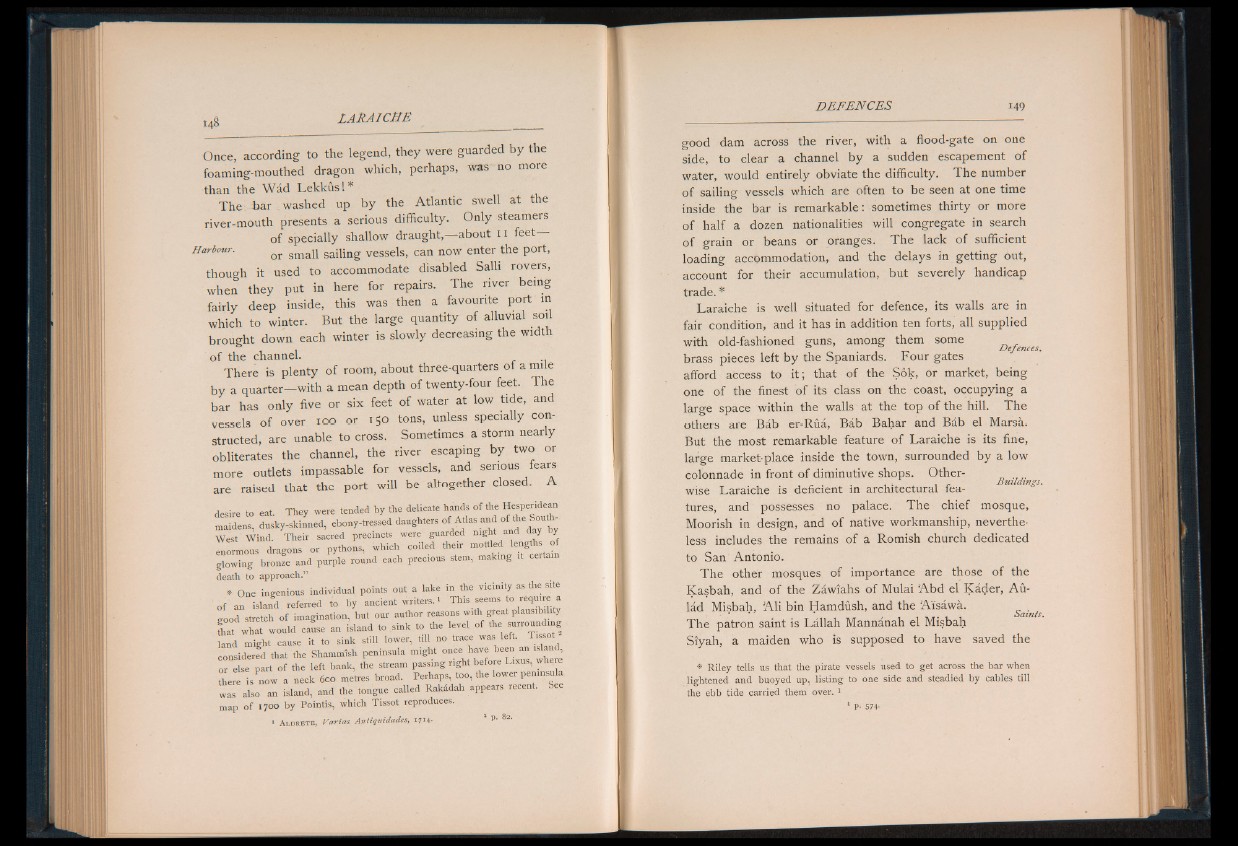
Once, according to the legend, they were guarded by the
foaming-mouthed dragon which, perhaps, was no more
than the Wad Lekkusl*
The bar washed up by the Atlantic swell at the
river-mouth presents a serious difficulty. Only steamers
of specially shallow draught,— about 11 feet
arbour. Qr small sajiing vessels, can now enter the port,
though it used to accommodate disabled Salli rovers,
when they put in here for repairs. The river being
fairly deep inside, this was then a favourite port in
which to winter. But the large quantity of alluvial soil
brought down each winter is slowly decreasing the width
of the channel.
There is plenty of room, about three-quarters of a mile
by a quarter— with a mean depth of twenty-four feet. The
bar has only five or six feet of water at low tide, and
vessels of over 100 or 150 tons, unless specially constructed,
are unable to cross. Sometimes a storm nearly
obliterates the channel, the river escaping by two or
more outlets impassable for vessels, and serious fears
are raised that the port will be altogether closed. A
desire to eat. They were tended by the delicate hands of the Hesperidean
maidens, dusky-skinned, ebony-tressed daughters A j f l U o fth eS o u t-
West Wind. Their sacred precincts were guarded night and day by
enormous dragons or pythons, which coiled their mottled lengths of
glowing bronze and purple round each precious stem, making it certai
death to approach.”
* One ingenious individual points out a lake in the vicinity as the sit
of an island referred to by ancient writer, 1 This seems to -q u u e a
¡rood stretch of imagination, but our author reasons with great plausibility
lhat what would cause an island to .sink to the level of the surrounding
land might cause it to sink still lower, till no trace was left. Tissot
considered that the Shammish peninsula might once have been an island,
or else part of the left bank, the stream passing right before Lixus, where
there is now a neck 6co metres broad. Perhaps, too, the lower peninsula
was also an island, and the tongue called Rakidah appears recent. See
map of 1700 by Pointis, which Tissot reproduces.
1 A l d r e t e , Varias Antiquidades, 1714- P- 2-
good dam across the river, with a flood-gate on one
side, to clear a channel by a sudden escapement of
water, would entirely obviate the difficulty. The number
of sailing vessels which are often to be seen at one time
inside the bar is remarkable: sometimes thirty or more
of half a dozen nationalities will congregate in search
of grain or beans or oranges. The lack of sufficient
loading accommodation, and the delays in getting out,
account for their accumulation, but severely handicap
trade. *
Laraiche is well situated for defence, its walls are in
fair condition, and it has in addition ten forts, all supplied
with old-fashioned guns, among them some Defences
brass pieces left by the Spaniards. Four gates
afford access to it; that of the Sok, or market, being
one of the finest of its class on the coast, occupying a
large space within the walls at the top of the hill. The
others are Bab er-Rua, Bab Bahar and Bab el Marsa.
But the most remarkable feature of Laraiche is its fine,
large market-place inside the town, surrounded by a low
colonnade in front of diminutive shops. Other-
1 _ tfuilaitigs.
wise Laraiche is deficient in architectural features,
and possesses no palace. The chief mosque,
Moorish in design, and of native workmanship, nevertheless
includes the remains of a Romish church dedicated
to San Antonio.
The other mosques of importance are those of the
Kasbah, and of the Zawiahs of Mulai Abd el Kader, Au-
lad Misbah, A li bin Hamdush, and the Aisawa. , bamts.
The patron saint is Lallah Mannanah el Misbah
Siyah, a maiden who is supposed to have saved the
* Riley tells us that the pirate vessels used to get across the bar when
lightened and buoyed up, listing to one side and steadied by cables till
the ebb tide carried them over. 1